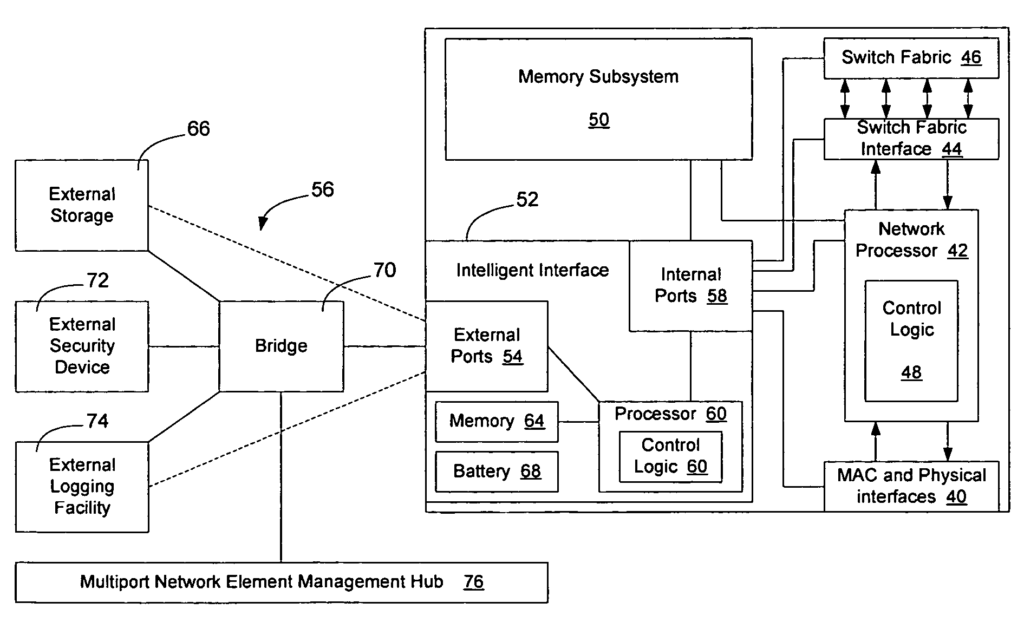ABSTRACT
A network element (NE) includes an intelligent interface (II) with its own operating environment rendering it active during the NE boot process, and with separate intelligence allowing it to take actions on the NE prior to, during, and after the boot process.
The combination of independent operation and increased intelligence provides enhanced management opportunities to enable the NE to be controlled throughout the boot process and after completion of the boot process. For example, files may be uploaded to the NE before or during the boot process to restart the NE from a new software image. The II allows this downloading process to occur in parallel on multiple NEs from a centralized storage resource. Diagnostic checks may be run on the NE, and files, and MIB information, and other data may be transmitted from the II to enable a network manager to more effectively manage the NE.

Intelligent Management of a network element
An Inventor: Dr. Tal Lavian
BACKGROUND OF THE INVENTION
1. Field of the Invention
The present invention relates to network elements and, more particularly, to a method and apparatus for intelligent management of a network element.
2. Description of the Related Art
Data communication networks may include various, hubs, switches, routers, and other network devices, interconnected and configured to handle data as it passes through the network.
These devices will be referred to herein as “network elements.” Data is communicated through the data communication network by passing data packets (or cells, frames, or segments) between the network elements by utilizing one or more communication links. A particular packet may be handled by multiple network elements and cross multiple communication links as it travels between its source and its destination over the network.
Network elements occasionally encounter failure due to a hardware problem or, more commonly, due to a problem with software that has been loaded onto the network element to enable the network element to perform advanced functions, such as switching, routing, filtering, and policing functions. The failure may be recoverable, i.e. may be one from which the network element may be restarted over the network. Certain instances of network element failure, however, are not recoverable and may even require a new software image to be loaded onto the network element. Similarly, routine updates to increase the functionality or reliability of the network element may require a new software image to be loaded onto the network element.
Conventional network elements contain a RS232 interface, or an equivalent interface, to enable a network engineer or other person to interface a laptop computer to the network element. Where the interface to the network element is an RS232 interface operating at 9.6 Kilobits per second (Kb/s), uploading a new image to the network element may take a considerable amount of time, especially as software images used by network elements have become increasingly large to accommodate the enhanced functionality expected of modern network elements. Indeed, given the size of current software images, which sometimes exceed 10 s of Mbytes, even where a RS232C port operating at 115 Kb/s is utilized, loading a new software image to the network element may take a considerable amount of time.
More importantly, a standard RS232 or RS232C interface requires the network element to be operational before access to the network element may be obtained. Management of the network element over a communications network, while faster than using a standard RS232 port, is likewise generally impossible in the event of network device failure. For example, where port 162/udp (or another network port) is used to enable a network element to be controlled using Simple Network Management Protocol (SNMP), network element failure generally renders the network element’s Management Information Base (MIB) inaccessible. Similarly, an Ethernet port is generally not operable without a full TCP protocol stack. Where the network device is experiencing failure, it may not be possible to load a full TCP stack, thus rendering the Ethernet management port largely useless. This prevents information associated with the failure from being accessible to the management station when it is needed most—during the failure. Accordingly, conventional ports cannot in many situations help a network manager identify and fix problems on network elements without rebooting the network element and trying to recreate or trace, after the fact, the cause of the fault.
SUMMARY OF THE INVENTION
The present invention overcomes these and other drawbacks by providing a method and apparatus for intelligent management of a network element.
According to an embodiment of the invention, a network element includes an intelligent interface that has its own microkernel to enable it to be active during the boot process before the network element has entered an operational state, and separate intelligence to enable it to take actions on the network element and interface with the network element prior to, during, and after the boot process. The combination of increased intelligence and independent operation provide enhanced management opportunities to enable the network element to be controlled before and during the boot process, as well as after the boot process has completed and the network element has begun operations in a run time environment.
Dr. Tal Lavian offers insightful and decisive expertise as a telecommunications expert witness and network communications expert witness.